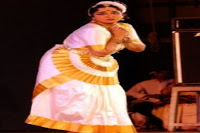Dance and Fashion - Their inseparable connection
Written by: Rutva Jadhav
(1st Winner of NrutyaShabda Dance Essay Writing Competition, 2020, Junior Group, Organized by Samvaad Performing Arts Blog - Swarada Dhekane and Loud Applause Dance E-Magazine - Neha Muthiyan)
Let’s get ready for the concert! Is the eyeliner too thick? Wow! This jewellery looks so ecstatic. Does this costume fit me well? These are just a few sentences I have listed out of hundreds I have heard while getting ready for my dance class concert. Well, robes and embellishments have played a crucial role in upgrading visual glamour of dance.
What does dance actually mean? A rhythmic movement(usually to music) expressing an emotion, releasing energy, or simply taking delight in the movement itself. Many people consider dance as a medium to convey inner expressions and feelings. The aspects of dance to name a few are flexibility, balance, mobility, flow and harmony with music and beats. Well, these elements differ from one culture or genre or type to another but, they are also seen to be changing with fashion. Dancers use their body as a tool to create art.
I agree with the iconic fashion designer Valentino, who while designing costumes for dancers says, “I have always designed thinking about the movement of the woman wearing the dress—where would she wear it, how would she move in it, and what does it mean to her. A dress should never be designed just to be viewed from just one angle; movement must be considered in an entire 360-degree point of view. Wearing clothing is about expressing emotion—just the way dance is.” There is a striking similarity between the elements of fashion design and dance choreography. Both require balance, emphasis, harmony, variety and rhythm.
The prosperous traditional dance forms of India have the potential of narrating tales, history and incidences through the medium of bodily gestures and movements. They are always so eye-catching and extremely beguiling to watch. The costumes of Indian classical dance are a significant part of any performance. The peculiarity of Indian classical dance is marked by the alluring costumes that the dancers wear.
In order to do this, Indian classical dancers wear makeup and costumes in a particular way. Makeup and costumes are considered as a part of Aharya Abhinaya. As an example, Kathakali is a dance form that uses rich Aharya. In Kathakali make up is considered as the basis of character definition. Make up is a segment of fashion.
In the earliest ballets of the 17th century, dancers traditionally wore heeled shoes and women wore heavy costumes similar to a court dress. In the early 18th century, the dancer Marie Camargo shortened her skirts to midcalf length, invented heelless dance slippers, and wore close-fitting drawers to facilitate and exhibit her mastery of intricate dance steps.
 |
| Marie Camargo |
Marie Taglioni introduced the “Romantic tutu” in 1832, a multi layered skirt reaching to midcalf, which by the 1880s was shortened to reveal the whole leg. The tutu became the standard costume in the 19th century. By the mid-20th century, a contemporary street dress took the place of tutu.
 |
| Marie Taglioni |
 |
| Practice costumes used for ballet |
 |
| Evolution of Ballet costumes |
Dr. Smt. Sucheta Chapekar wanted the soul of Bharata Natyam to take roots in the system of Hindustani Classical Music. So, she created Nrityaganga- A Synthesis of Bharata Natyam and Hindustani Classical Music. As Nrityaganga is a unique blend of Bharata Natyam and Hindustani Classical Music, the costume for Nrityaganga is also distinctive. An element of traditional Maharashtrian attire, Kashta and the side fan of Bharata Natyam were unified. So, the Kashta gave the costume of this style of Bharata Natyam an exquisite peculiarity. Maharashtrian ‘Chinchpeti’ was worn as jewellery.
 |
| Side fan of Bharatanatyam |
 |
| Kashta |
 |
| Front and back view of the Nrityaganga costumes |
Dance and fashion entwine with one another. Movements allow fashion to take an exciting form. Rachel Zoe an American fashion designer once quoted, ’’Style is a way of saying who you are without having to speak’’. Fashion is the latest style of clothing, hair, decoration, etc. Do dancers have a distinctive way of dancing? Yes, of course they do. That is a dancer’s own unique style of dance. Although they may get trained from a professional, teacher or someone they look up to, they still dance like their own selves. Just like style in fashion is something timeless, evolving and is person specific, a style of dance varies from person to person, and the modernity of something may also influence choreography. Just like style of fashion, style of dance is a mode of self-expression. So, do it big, do it right and do it with ‘STYLE’.
_________________________________________________________________________________
References:-
1. https://www.britannica.com/art/ballet-costume
2. https://mymodernmet.com/style-of-movement-nyc-dance-project/
3. https://www.gktoday.in/gk/concept-of-abhinaya-in-indian-performing-arts/
1. https://www.britannica.com/art/ballet-costume
2. https://mymodernmet.com/style-of-movement-nyc-dance-project/
3. https://www.gktoday.in/gk/concept-of-abhinaya-in-indian-performing-arts/
***








Comments
Post a Comment